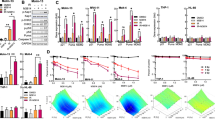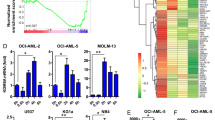Abstract
Various tumor-therapeutic drugs and environmental carcinogens alkylate DNA inducing O6-methylguanine (O6MeG) that provokes cell death by apoptosis. In rodent fibroblasts, apoptosis triggered by O6MeG is executed via the mitochondrial damage pathway. Conversion of O6MeG into critical downstream lesions requires mismatch repair (MMR). This is thought to signal apoptosis upon binding to O6MeG lesions mispaired with thymine. Alternatively, O6MeG lesions might be processed by MMR giving rise to DNA double-strand breaks (DSBs) during replication that finally provoke apoptosis. To test this, we examined apoptosis triggered by O6MeG in human peripheral lymphocytes in which O6-methylguanine-DNA methyltransferase (MGMT) had been inactivated by O6-benzylguanine (O6BG) and which were not proliferating or proliferating upon CD3/CD28 stimulation. Treatment with N-methyl-N′-nitro-N-nitrosoguanidine (MNNG) or the anticancer drug temozolomide induced apoptosis only in proliferating, but not resting cells. With exceptional high alkylation doses (≥15 μ M of MNNG), apoptosis was also observed in resting lymphocytes, albeit at a lower level than in proliferating cells. This response was not affected by O6BG, suggesting that replication-independent apoptosis at high dose levels is caused by lesions other than O6MeG. O6MeG-triggered apoptosis in proliferating lymphocytes was preceded by a wave of DSBs, which coincided with p53 and Fas receptor upregulation, while Fas ligand, Bax and Bcl-2 expression was not altered. Treatment with anti-Fas neutralizing antibody attenuated MNNG-induced apoptosis in MGMT-depleted proliferating lymphocytes. The data suggest that O6MeG is converted by MMR and DNA replication into DSBs that trigger apoptosis by p53 stabilization and Fas/CD95/Apo-1 upregulation. This is supported by the finding that ionizing radiation, inducing DSBs on its own, provokes apoptosis in lymphocytes in a replication-independent way. The strict proliferation dependence of apoptosis triggered by O6MeG may explain the specific killing response of MGMT-deficient proliferating cells, including tumors, to O6MeG generating anticancer drugs and suggests that tumor proliferation rate, Fas responsiveness, MGMT and MMR status are important prognosis parameters.
This is a preview of subscription content, access via your institution
Access options
Subscribe to this journal
Receive 50 print issues and online access
$259.00 per year
only $5.18 per issue
Buy this article
- Purchase on Springer Link
- Instant access to full article PDF
Prices may be subject to local taxes which are calculated during checkout








Similar content being viewed by others
References
Becker K, Dosch J, Gregel CM, Martin BM and Kaina B . (1996). Cancer Res., 56, 3244–3249.
Becker R, Ritter A, Eichhorn U, Lips J, Bertram B, Wiessler M, Zdzienicka MZ and Kaina B . (2002). Br. J. Cancer, 86, 130–135.
Beranek DT . (1990). Mutat. Res., 231, 11–30.
Brennand J and Margison GP . (1986). Proc. Natl. Acad. Sci. USA, 83, 6292–6296.
Coquerelle T, Dosch J and Kaina B . (1995). Mutat. Res., 336, 9–17.
De Wind N, Dekker M, Berns A, Radman M and te Riele H . (1995). Cell, 82, 321–330.
Dikomey E, Dahm-Daphi J, Brammer I, Martensen R and Kaina B . (1998). Int. J. Radiat. Biol., 73, 269–278.
Dosch J, Christmann M and Kaina B . (1998). Carcinogenesis, 4, 567–573.
Dosch J and Kaina B . (1996). Oncogene, 13, 1927–1935.
Duckett DR, Drummond JT, Hurchie AIH, Reardon JT, Sancar A, Lilley DM and Modrich P . (1996). Proc. Natl. Acad. Sci. USA, 93, 6443–6447.
Dunkern TR, Fritz G and Kaina B . (2001a). Mutat. Res., 486, 249–258.
Dunkern TR, Fritz G and Kaina B . (2001b). Oncogene, 20, 6026–6038.
Dunkern TR and Kaina B . (2002). Mol. Biol. Cell, 13, 348–361.
Dunkern TR, Roos W and Kaina B . (2003). Mutation Research, in press.
Fishel R . (1999). Nat. Med., 5, 1239–1240.
Galloway SM, Greenwood SK, Hill RB, Bradt CI and Bean CL . (1995). Mutat. Res., 346, 231–245.
Gerson S, Phillips W, Kastan M, Dumenco L and Donovan C . (1996). Blood, 88, 1649–1655.
Hammond LA, Eckardt JR, Baker SD, Eckhardt SG, Dugan M, Forral K, Reidenberg P, Statkevich P, Weiss GR, Rinaldi DA, Von Hoff DD and Rowinsky EK . (1999). J. Clin. Oncol., 17, 2604–2613.
Hickman MJ and Samson LD . (1999). Proc. Natl. Acad. Sci. USA, 96, 10764–10769.
Holbrook NJ and Fornace Jr AJ . (1991). N. Biol., 3, 825–833.
Janssen K, Grombacher U, Schlink K, Nitzsche S, Oesch F and Kaina B . (2001). Arch. Toxicol., 75, 306–312.
Jones DT, Ganeshaguru K, Virchis AE, Folarin NI, Lowdell MW, Mehta AB, Prentice HG, Hoffbrand AV and Wickremasinghe RG . (2001). Blood, 98, 2800–2807.
Kaina B . (1985). Mutat. Res., 142, 49–54.
Kaina B, Fritz G and Coquerelle T . (1993). Environ. Mol. Mutagen., 22, 283–292.
Kaina B, Fritz G, Mitra S and Coquerelle T . (1991). Carcinogenesis, 12, 1857–1867.
Kaina B, Ziouta A, Ochs K and Coquerelle T . (1997). Mutat. Res., 381, 227–241.
Karran P and Bignami M . (1994). Bioassays, 16, 833–839.
Karran P and Stephenson C . (1990). Mutat. Res., 236, 269–275.
Kasibhatla S, Brunner T, Genestier L, Echeverri F, Mahboubi A and Green DR . (1998). Mol. Cell, 1, 543–551.
Kat A, Thilly WG, Fang WH, Longley MJ, Li G-M and Modrich P . (1993). Proc. Natl. Acad. Sci. USA, 90, 6424–6428.
Lips J and Kaina B . (2001). Carcinogenesis, 22, 579–585.
Mansouri A, Ridgway LD, Korapati AL, Zhang Q, Tian L, Wang Y, Siddik ZH, Mills GB and Claret FX . (2003). J. Biol. Chem., 218, 19245–19256
Margison GP and Santibanez-Koref MF . (2002). BioEssays, 24, 255–266.
Marra G, D'Atri S, Corti C, Bonmassar L, Cattaruzza MS, Schweizer P, Heinimann K, Bartosova Z, Nystrom-Lahti M and Jiricny J . (2001). Proc. Natl. Acad. Sci. USA, 98, 7164–7169.
Meikrantz W, Bergom MA, Memisoglu A and Samson L . (1998). Carcinogenesis, 19, 369–372.
Moritz T, Mackay W, Glassner BJ, Williams DA and Samson L . (1995). Cancer Res., 55, 2608–2614.
Moschel RC, McDougall MG, Dolan ME, Stine L and Pegg AE . (1992). J. Med. Chem., 35, 4486–4491.
Muller M, Wilder S, Bannasch Israeli D, Lehlbach K, Li-Weber M, Friedman SL, Galle PR, Stremmel W, Oren M and Krammer PH . (1998). J. Exp. Med., 188, 2033–2045.
Ochs K and Kaina B . (2000). Cancer Res., 60, 5815–5824.
Ochs K, Lips J, Profittlich S and Kaina B . (2002). Cancer Res., 62, 1524–1530.
Olive PL, Wlodek D and Banath JP . (1991). Cancer Res., 51, 4671–4676.
Peter ME and Krammer PH . (2003). Cell Death Differ., 10, 26–35.
Raju U, Gumin GJ and Tofilon PJ . (2000). Int. J. Radiat. Biol., 76, 1045–1053.
Rogakou EP, Pilch DR, Orr AH, Ivanova VS and Bonner WM . (1998). J. Biol. Chem., 273, 5858–5868.
Tominaga Y, Tsuzuki T, Shiraishi A, Kawate H and Sekiguchi M . (1997). Carcinogenesis, 18, 889–896.
Vermes I, Haanen C, Steffens-Nakken H and Reutelingsberger C . (1995). J. Immunol. Methods, 184, 39–51.
Acknowledgements
This work was supported by Deutsche Forschungsgemeinschaft, DFG.Ka724/10-1 and SFB519/B4.
Author information
Authors and Affiliations
Corresponding author
Rights and permissions
About this article
Cite this article
Roos, W., Baumgartner, M. & Kaina, B. Apoptosis triggered by DNA damage O6-methylguanine in human lymphocytes requires DNA replication and is mediated by p53 and Fas/CD95/Apo-1. Oncogene 23, 359–367 (2004). https://doi.org/10.1038/sj.onc.1207080
Received:
Revised:
Accepted:
Published:
Issue Date:
DOI: https://doi.org/10.1038/sj.onc.1207080
Keywords
This article is cited by
-
Class I HDAC overexpression promotes temozolomide resistance in glioma cells by regulating RAD18 expression
Cell Death & Disease (2022)
-
Arsenic exposure increased expression of HOTAIR and LincRNA-p21 in vivo and vitro
Environmental Science and Pollution Research (2021)
-
Methadone-mediated sensitization of glioblastoma cells is drug and cell line dependent
Journal of Cancer Research and Clinical Oncology (2021)
-
Sensitivity of CD3/CD28-stimulated versus non-stimulated lymphocytes to ionizing radiation and genotoxic anticancer drugs: key role of ATM in the differential radiation response
Cell Death & Disease (2018)
-
Intravenous Formulation of HET0016 Decreased Human Glioblastoma Growth and Implicated Survival Benefit in Rat Xenograft Models
Scientific Reports (2017)



